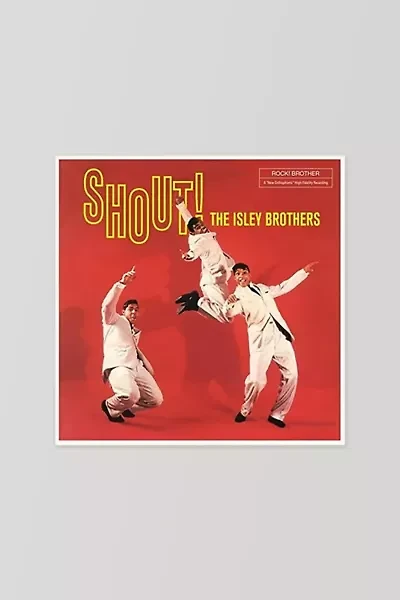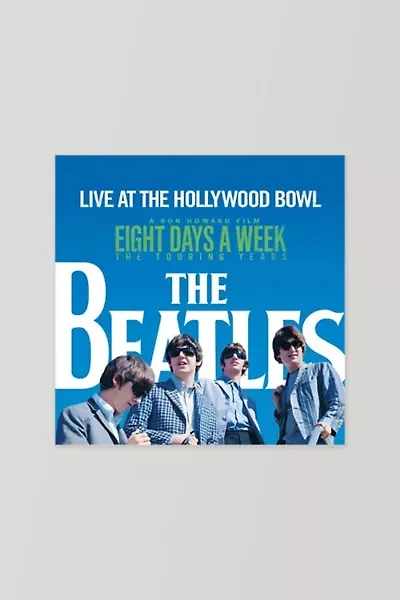Home
Live at the Hollywood Bowl [Bonus Tracks] [LP]
Barnes and Noble
Loading Inventory...
Live at the Hollywood Bowl [Bonus Tracks] [LP]
Current price: $19.99
![Live at the Hollywood Bowl [Bonus Tracks] [LP]](https://prodimage.images-bn.com/pimages/0602557054996_p0_v2_s600x595.jpg)
Barnes and Noble
Live at the Hollywood Bowl [Bonus Tracks] [LP]
Current price: $19.99
Loading Inventory...
Size: CD
*Product information may vary - to confirm product availability, pricing, shipping and return information please contact Barnes and Noble
Capitol Records
initially planned to release a live album from
the Beatles
in 1964, recording the band's August 23 concert at the Hollywood Bowl. Nobody at the label found the results satisfactory so they attempted it again almost exactly a year later, taping the August 29 and 30, 1965 shows at the Hollywood Bowl but, once again, it proved hard to hear
the Fab Four
from underneath the roar of the crowd, so those tapes were also shelved. They remained in the vaults until 1977, when
Capitol
president
Bhaskar Menon
asked
George Martin
to assemble a listenable live album from the two sets of Hollywood Bowl tapes, all with the idea of combating the rise of bootlegs and quasi-legit
Beatles
live albums. It was a difficult task, yet
Martin
and engineer
Geoff Emerick
managed to assemble a 13-track LP of highlights that was quite well received upon its 1977 release yet managed to earn a reputation as something of a disappointment in part due to the screams that overwhelmed the band. Whenever the
catalog saw a digital release -- either in 1987 or in 2009 -- it was always left behind, not receiving a revision until 2016 when
's son
Giles
remastered the recordings, including four bonus tracks, for a CD/digital release to accompany
Ron Howard
's documentary Eight Days a Week: The Touring Years.
Giles Martin
's remastering does
Live at the Hollywood Bowl
a world of good, managing to somewhat suppress the thundering cheers without excising them at all, then boosting
so it's possible to focus on their crackerjack interplay. Perhaps
weren't able to hear themselves well on-stage but that's hard to discern from these performances, which are tight and swinging with the band clearly deriving energy from the audience. That's the primary difference between
and the two volumes of
Live at the BBC
: no matter how excellent those BBC collections are, there's no sense of the kinetic connection between
and their fans, something that's in ample display on
. Decades later, it's still thrilling to hear the band and the crowd feed off the excitement of the other. ~ Stephen Thomas Erlewine
initially planned to release a live album from
the Beatles
in 1964, recording the band's August 23 concert at the Hollywood Bowl. Nobody at the label found the results satisfactory so they attempted it again almost exactly a year later, taping the August 29 and 30, 1965 shows at the Hollywood Bowl but, once again, it proved hard to hear
the Fab Four
from underneath the roar of the crowd, so those tapes were also shelved. They remained in the vaults until 1977, when
Capitol
president
Bhaskar Menon
asked
George Martin
to assemble a listenable live album from the two sets of Hollywood Bowl tapes, all with the idea of combating the rise of bootlegs and quasi-legit
Beatles
live albums. It was a difficult task, yet
Martin
and engineer
Geoff Emerick
managed to assemble a 13-track LP of highlights that was quite well received upon its 1977 release yet managed to earn a reputation as something of a disappointment in part due to the screams that overwhelmed the band. Whenever the
catalog saw a digital release -- either in 1987 or in 2009 -- it was always left behind, not receiving a revision until 2016 when
's son
Giles
remastered the recordings, including four bonus tracks, for a CD/digital release to accompany
Ron Howard
's documentary Eight Days a Week: The Touring Years.
Giles Martin
's remastering does
Live at the Hollywood Bowl
a world of good, managing to somewhat suppress the thundering cheers without excising them at all, then boosting
so it's possible to focus on their crackerjack interplay. Perhaps
weren't able to hear themselves well on-stage but that's hard to discern from these performances, which are tight and swinging with the band clearly deriving energy from the audience. That's the primary difference between
and the two volumes of
Live at the BBC
: no matter how excellent those BBC collections are, there's no sense of the kinetic connection between
and their fans, something that's in ample display on
. Decades later, it's still thrilling to hear the band and the crowd feed off the excitement of the other. ~ Stephen Thomas Erlewine
Capitol Records
initially planned to release a live album from
the Beatles
in 1964, recording the band's August 23 concert at the Hollywood Bowl. Nobody at the label found the results satisfactory so they attempted it again almost exactly a year later, taping the August 29 and 30, 1965 shows at the Hollywood Bowl but, once again, it proved hard to hear
the Fab Four
from underneath the roar of the crowd, so those tapes were also shelved. They remained in the vaults until 1977, when
Capitol
president
Bhaskar Menon
asked
George Martin
to assemble a listenable live album from the two sets of Hollywood Bowl tapes, all with the idea of combating the rise of bootlegs and quasi-legit
Beatles
live albums. It was a difficult task, yet
Martin
and engineer
Geoff Emerick
managed to assemble a 13-track LP of highlights that was quite well received upon its 1977 release yet managed to earn a reputation as something of a disappointment in part due to the screams that overwhelmed the band. Whenever the
catalog saw a digital release -- either in 1987 or in 2009 -- it was always left behind, not receiving a revision until 2016 when
's son
Giles
remastered the recordings, including four bonus tracks, for a CD/digital release to accompany
Ron Howard
's documentary Eight Days a Week: The Touring Years.
Giles Martin
's remastering does
Live at the Hollywood Bowl
a world of good, managing to somewhat suppress the thundering cheers without excising them at all, then boosting
so it's possible to focus on their crackerjack interplay. Perhaps
weren't able to hear themselves well on-stage but that's hard to discern from these performances, which are tight and swinging with the band clearly deriving energy from the audience. That's the primary difference between
and the two volumes of
Live at the BBC
: no matter how excellent those BBC collections are, there's no sense of the kinetic connection between
and their fans, something that's in ample display on
. Decades later, it's still thrilling to hear the band and the crowd feed off the excitement of the other. ~ Stephen Thomas Erlewine
initially planned to release a live album from
the Beatles
in 1964, recording the band's August 23 concert at the Hollywood Bowl. Nobody at the label found the results satisfactory so they attempted it again almost exactly a year later, taping the August 29 and 30, 1965 shows at the Hollywood Bowl but, once again, it proved hard to hear
the Fab Four
from underneath the roar of the crowd, so those tapes were also shelved. They remained in the vaults until 1977, when
Capitol
president
Bhaskar Menon
asked
George Martin
to assemble a listenable live album from the two sets of Hollywood Bowl tapes, all with the idea of combating the rise of bootlegs and quasi-legit
Beatles
live albums. It was a difficult task, yet
Martin
and engineer
Geoff Emerick
managed to assemble a 13-track LP of highlights that was quite well received upon its 1977 release yet managed to earn a reputation as something of a disappointment in part due to the screams that overwhelmed the band. Whenever the
catalog saw a digital release -- either in 1987 or in 2009 -- it was always left behind, not receiving a revision until 2016 when
's son
Giles
remastered the recordings, including four bonus tracks, for a CD/digital release to accompany
Ron Howard
's documentary Eight Days a Week: The Touring Years.
Giles Martin
's remastering does
Live at the Hollywood Bowl
a world of good, managing to somewhat suppress the thundering cheers without excising them at all, then boosting
so it's possible to focus on their crackerjack interplay. Perhaps
weren't able to hear themselves well on-stage but that's hard to discern from these performances, which are tight and swinging with the band clearly deriving energy from the audience. That's the primary difference between
and the two volumes of
Live at the BBC
: no matter how excellent those BBC collections are, there's no sense of the kinetic connection between
and their fans, something that's in ample display on
. Decades later, it's still thrilling to hear the band and the crowd feed off the excitement of the other. ~ Stephen Thomas Erlewine
![Nirvana [LP] [Bonus Tracks]](https://prodimage.images-bn.com/pimages/0602547378781_p0_v2_s600x595.jpg)
![Doris [Bonus Tracks] [LP]](https://prodimage.images-bn.com/pimages/0888837517010_p0_v3_s600x595.jpg)

![Live in Geneva 1995 [Bonus Track]](https://prodimage.images-bn.com/pimages/5055011704022_p0_v2_s600x595.jpg)
![About Last Night [Bonus Track LP]](https://prodimage.images-bn.com/pimages/0888430007314_p0_v2_s600x595.jpg)

![Tron: Legacy [2 LP] [Bonus Tracks]](https://prodimage.images-bn.com/pimages/0050087239855_p0_v2_s600x595.jpg)
![Emperor of Sand [LP] [Bonus Tracks]](https://prodimage.images-bn.com/pimages/0093624914051_p0_v1_s600x595.jpg)
![Life After Death [LP] [Bonus Tracks]](https://prodimage.images-bn.com/pimages/0081227960704_p0_v1_s600x595.jpg)

![24 Hour Revenge Therapy [Bonus Tracks] [LP]](https://prodimage.images-bn.com/pimages/0655035131016_p0_v2_s600x595.jpg)






